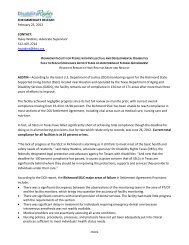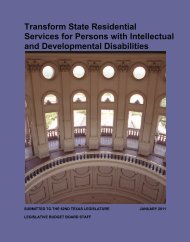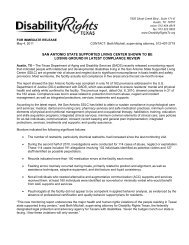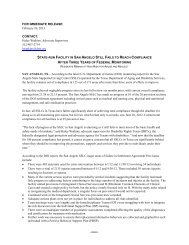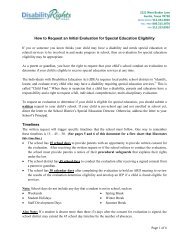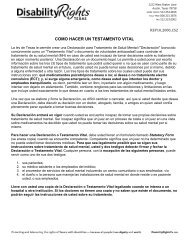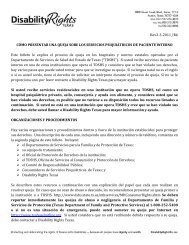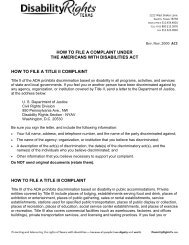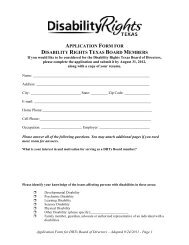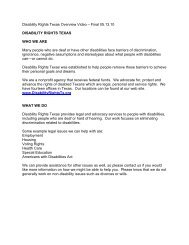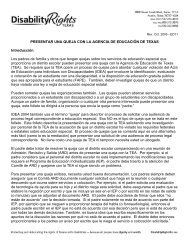- Page 1 and 2: United States v. State of Texas Mon
- Page 3 and 4: Introduction Background In 2009, th
- Page 5 and 6: a) Steps Taken to Assess Compliance
- Page 7 and 8: First, the Monitoring Team wishes t
- Page 9 and 10: o The rate of restraint use at RGSC
- Page 11 and 12: o The Facility QA process did not a
- Page 13 and 14: o Improvement is needed in using cl
- Page 15 and 16: Medical Care The Monitoring Team no
- Page 17 and 18: o The Facility must develop and imp
- Page 19 and 20: o The Facility did not have a mecha
- Page 21 and 22: o The Facility had improved in prov
- Page 23 and 24: Status of Compliance with the Settl
- Page 25 and 26: estraint for those who still requir
- Page 27 and 28: # Provision Assessment of Status Co
- Page 29 and 30: # Provision Assessment of Status Co
- Page 31 and 32: # Provision Assessment of Status Co
- Page 33 and 34: # Provision Assessment of Status Co
- Page 35 and 36: # Provision Assessment of Status Co
- Page 37 and 38: # Provision Assessment of Status Co
- Page 39 and 40: # Provision Assessment of Status Co
- Page 41: # Provision Assessment of Status Co
- Page 45 and 46: # Provision Assessment of Status Co
- Page 47 and 48: # Provision Assessment of Status Co
- Page 49 and 50: # Provision Assessment of Status Co
- Page 51 and 52: # Provision Assessment of Status Co
- Page 53 and 54: # Provision Assessment of Status Co
- Page 55 and 56: 31. Facility investigations for ser
- Page 57 and 58: impacts the Facility’s ability to
- Page 59 and 60: # Provision Assessment of Status Co
- Page 61 and 62: # Provision Assessment of Status Co
- Page 63 and 64: # Provision Assessment of Status Co
- Page 65 and 66: # Provision Assessment of Status Co
- Page 67 and 68: # Provision Assessment of Status Co
- Page 69 and 70: # Provision Assessment of Status Co
- Page 71 and 72: # Provision Assessment of Status Co
- Page 73 and 74: # Provision Assessment of Status Co
- Page 75 and 76: # Provision Assessment of Status Co
- Page 77 and 78: # Provision Assessment of Status Co
- Page 79 and 80: # Provision Assessment of Status Co
- Page 81 and 82: # Provision Assessment of Status Co
- Page 83 and 84: # Provision Assessment of Status Co
- Page 85 and 86: # Provision Assessment of Status Co
- Page 87 and 88: # Provision Assessment of Status Co
- Page 89 and 90: # Provision Assessment of Status Co
- Page 91 and 92: # Provision Assessment of Status Co
- Page 93 and 94:
# Provision Assessment of Status Co
- Page 95 and 96:
# Provision Assessment of Status Co
- Page 97 and 98:
# Provision Assessment of Status Co
- Page 99 and 100:
SECTION E: Quality Assurance Commen
- Page 101 and 102:
clinical outcomes. The Facility may
- Page 103 and 104:
# Provision Assessment of Status Co
- Page 105 and 106:
# Provision Assessment of Status Co
- Page 107 and 108:
# Provision Assessment of Status Co
- Page 109 and 110:
# Provision Assessment of Status Co
- Page 111 and 112:
# Provision Assessment of Status Co
- Page 113 and 114:
# Provision Assessment of Status Co
- Page 115 and 116:
# Provision Assessment of Status Co
- Page 117 and 118:
# Provision Assessment of Status Co
- Page 119 and 120:
# Provision Assessment of Status Co
- Page 121 and 122:
data, including specific sampling p
- Page 123 and 124:
# Provision Assessment of Status Co
- Page 125 and 126:
# Provision Assessment of Status Co
- Page 127 and 128:
# Provision Assessment of Status Co
- Page 129 and 130:
# Provision Assessment of Status Co
- Page 131 and 132:
# Provision Assessment of Status Co
- Page 133 and 134:
# Provision Assessment of Status Co
- Page 135 and 136:
# Provision Assessment of Status Co
- Page 137 and 138:
# Provision Assessment of Status Co
- Page 139 and 140:
# Provision Assessment of Status Co
- Page 141 and 142:
# Provision Assessment of Status Co
- Page 143 and 144:
However, the rationale for the self
- Page 145 and 146:
# Provision Assessment of Status Co
- Page 147 and 148:
# Provision Assessment of Status Co
- Page 149 and 150:
# Provision Assessment of Status Co
- Page 151 and 152:
to develop and implement a procedur
- Page 153 and 154:
# Provision Assessment of Status Co
- Page 155 and 156:
# Provision Assessment of Status Co
- Page 157 and 158:
# Provision Assessment of Status Co
- Page 159 and 160:
changes in an individual’s status
- Page 161 and 162:
Summary of Monitors Assessment: In
- Page 163 and 164:
# Provision Assessment of Status Co
- Page 165 and 166:
# Provision Assessment of Status Co
- Page 167 and 168:
# Provision Assessment of Status Co
- Page 169 and 170:
ehavioral data and provided accurat
- Page 171 and 172:
issues, and that these issues be re
- Page 173 and 174:
e used as punishment. Assessments (
- Page 175 and 176:
J8 assessment and diagnosis (if a p
- Page 177 and 178:
alternative treatment strategies ar
- Page 179 and 180:
each Facility shall obtain informed
- Page 181 and 182:
SECTION K: Psychological Care and S
- Page 183 and 184:
An additional area of substantial c
- Page 185 and 186:
# Provision Assessment of Status Co
- Page 187 and 188:
# Provision Assessment of Status Co
- Page 189 and 190:
# Provision Assessment of Status Co
- Page 191 and 192:
# Provision Assessment of Status Co
- Page 193 and 194:
# Provision Assessment of Status Co
- Page 195 and 196:
# Provision Assessment of Status Co
- Page 197 and 198:
# Provision Assessment of Status Co
- Page 199 and 200:
mental illness, as well as where th
- Page 201 and 202:
31. Integrated Progress Notes for I
- Page 203 and 204:
address important system issues tha
- Page 205 and 206:
# Provision Assessment of Status Co
- Page 207 and 208:
# Provision Assessment of Status Co
- Page 209 and 210:
# Provision Assessment of Status Co
- Page 211 and 212:
# Provision Assessment of Status Co
- Page 213 and 214:
# Provision Assessment of Status Co
- Page 215 and 216:
# Provision Assessment of Status Co
- Page 217 and 218:
# Provision Assessment of Status Co
- Page 219 and 220:
# Provision Assessment of Status Co
- Page 221 and 222:
disease, be assessed by necessary s
- Page 223 and 224:
33. State Supported Living Center (
- Page 225 and 226:
7. Annual ISP Meeting for Individua
- Page 227 and 228:
# Provision Assessment of Status Co
- Page 229 and 230:
# Provision Assessment of Status Co
- Page 231 and 232:
# Provision Assessment of Status Co
- Page 233 and 234:
# Provision Assessment of Status Co
- Page 235 and 236:
# Provision Assessment of Status Co
- Page 237 and 238:
# Provision Assessment of Status Co
- Page 239 and 240:
# Provision Assessment of Status Co
- Page 241 and 242:
# Provision Assessment of Status Co
- Page 243 and 244:
# Provision Assessment of Status Co
- Page 245 and 246:
# Provision Assessment of Status Co
- Page 247 and 248:
# Provision Assessment of Status Co
- Page 249 and 250:
# Provision Assessment of Status Co
- Page 251 and 252:
# Provision Assessment of Status Co
- Page 253 and 254:
# Provision Assessment of Status Co
- Page 255 and 256:
# Provision Assessment of Status Co
- Page 257 and 258:
# Provision Assessment of Status Co
- Page 259 and 260:
# Provision Assessment of Status Co
- Page 261 and 262:
# Provision Assessment of Status Co
- Page 263 and 264:
# Provision Assessment of Status Co
- Page 265 and 266:
# Provision Assessment of Status Co
- Page 267 and 268:
# Provision Assessment of Status Co
- Page 269 and 270:
# Provision Assessment of Status Co
- Page 271 and 272:
1. The Facility should expect physi
- Page 273 and 274:
N1, and rated substantial complianc
- Page 275 and 276:
concern because the pharmacist was
- Page 277 and 278:
# Provision Assessment of Status Co
- Page 279 and 280:
# Provision Assessment of Status Co
- Page 281 and 282:
# Provision Assessment of Status Co
- Page 283 and 284:
# Provision Assessment of Status Co
- Page 285 and 286:
# Provision Assessment of Status Co
- Page 287 and 288:
i. During the past 6 months, have h
- Page 289 and 290:
ensure PNM supports for individuals
- Page 291 and 292:
# Provision Assessment of Status Co
- Page 293 and 294:
# Provision Assessment of Status Co
- Page 295 and 296:
# Provision Assessment of Status Co
- Page 297 and 298:
# Provision Assessment of Status Co
- Page 299 and 300:
# Provision Assessment of Status Co
- Page 301 and 302:
# Provision Assessment of Status Co
- Page 303 and 304:
SECTION P: Physical and Occupationa
- Page 305 and 306:
Provision P.3: This provision was d
- Page 307 and 308:
# Provision Assessment of Status Co
- Page 309 and 310:
# Provision Assessment of Status Co
- Page 311 and 312:
# Provision Assessment of Status Co
- Page 313 and 314:
# Provision Assessment of Status Co
- Page 315 and 316:
primarily in the area of oral hygie
- Page 317 and 318:
# Provision Assessment of Status Co
- Page 319 and 320:
# Provision Assessment of Status Co
- Page 321 and 322:
SECTION R: Communication Each Facil
- Page 323 and 324:
communication devices or integratio
- Page 325 and 326:
# Provision Assessment of Status Co
- Page 327 and 328:
# Provision Assessment of Status Co
- Page 329 and 330:
# Provision Assessment of Status Co
- Page 331 and 332:
# Provision Assessment of Status Co
- Page 333 and 334:
SECTION S: Habilitation, Training,
- Page 335 and 336:
The Facility had requested that the
- Page 337 and 338:
# Provision Assessment of Status Co
- Page 339 and 340:
# Provision Assessment of Status Co
- Page 341 and 342:
# Provision Assessment of Status Co
- Page 343 and 344:
# Provision Assessment of Status Co
- Page 345 and 346:
SECTION T: Serving Institutionalize
- Page 347 and 348:
1. Alma Ortiz, Admissions/Placement
- Page 349 and 350:
# Provision Assessment of Status Co
- Page 351 and 352:
# Provision Assessment of Status Co
- Page 353 and 354:
# Provision Assessment of Status Co
- Page 355 and 356:
# Provision Assessment of Status Co
- Page 357 and 358:
# Provision Assessment of Status Co
- Page 359 and 360:
# Provision Assessment of Status Co
- Page 361 and 362:
# Provision Assessment of Status Co
- Page 363 and 364:
# Provision Assessment of Status Co
- Page 365 and 366:
# Provision Assessment of Status Co
- Page 367 and 368:
# Provision Assessment of Status Co
- Page 369 and 370:
# Provision Assessment of Status Co
- Page 371 and 372:
# Provision Assessment of Status Co
- Page 373 and 374:
# Provision Assessment of Status Co
- Page 375 and 376:
SECTION U: Consent Steps Taken to A
- Page 377 and 378:
taken creative action to recruit an
- Page 379 and 380:
# Provision Assessment of Status Co
- Page 381 and 382:
# Provision Assessment of Status Co
- Page 383 and 384:
# Provision Assessment of Status Co
- Page 385 and 386:
1. The Facility must ensure the com
- Page 387 and 388:
1. Leticia Gonzalez, RHIT, Health I
- Page 389 and 390:
# Provision Assessment of Status Co
- Page 391 and 392:
# Provision Assessment of Status Co
- Page 393 and 394:
# Provision Assessment of Status Co
- Page 395 and 396:
# Provision Assessment of Status Co
- Page 397 and 398:
# Provision Assessment of Status Co
- Page 399 and 400:
# Provision Assessment of Status Co
- Page 401 and 402:
# Provision Assessment of Status Co
- Page 403 and 404:
# Provision Assessment of Status Co
- Page 405 and 406:
CMS Centers for Medicare and Medica
- Page 407 and 408:
NOO Nurse Operations Officer NP Nur
- Page 409:
UTI Urinary Tract Infection VCF Vir



